Assessment of the Relations for Determining the Profitability of Dairy Farms, A Premise of Their Economic Sustainability
Abstract
1. Introduction
2. Materials and Methods
3. Findings and Discussions
3.1. Distribution of Farms in Case Studies
3.2. Centralized Data Analysis
3.3. Correlation of Farm Size with Production, by Landforms
4. Conclusions
Author Contributions
Funding
Institutional Review Board Statement
Informed Consent Statement
Data Availability Statement
Conflicts of Interest
References
- Spicka, J.; Smutka, L. The Technical Efficiency of Specialised Milk Farms: A Regional View. Sci. World J. 2014, 2014, 985149. [Google Scholar] [CrossRef] [PubMed]
- Kingwell, R. Managing complexity in modern farming. Aust. J. Agric. Resour. Econ. 2011, 55, 12–34. [Google Scholar] [CrossRef]
- Bragg, L.; Dalton, T. Factors Affecting the Decision to Exit Dairy Farming: A Two-Stage Regression Analysis. J. Dairy Sci. 2004, 87, 3092–3098. [Google Scholar] [CrossRef]
- Xie, H.; Huang, Y.; Chen, Q.; Zhang, Y.; Wu, Q. Prospects for Agricultural Sustainable Intensification: A Review of Research. Land 2019, 8, 157. [Google Scholar] [CrossRef]
- Tey, Y.S.; Brindal, M. Factors Influencing Farm Profitability. In Sustainable Agriculture Reviews; Lichtfouse, E., Ed.; Springer: Cham, Switzerland, 2015; Volume 15. [Google Scholar] [CrossRef]
- Bewley, J. Precision Dairy Farming: Advanced Analysis Solutions for Future Profitability. The First North American Conference on Precision Dairy Management. 2010. Available online: https://www.researchgate.net/profile/Jeffrey-Bewley/publication/267711814_Precision_Dairy_Farming_Advanced_Analysis_Solutions_for_Future_Profitability/links/582f650f08ae138f1c0356cd/Precision-Dairy-Farming-Advanced-Analysis-Solutions-for-Future-Profitability.pdf (accessed on 18 April 2022).
- Hansson, H.; Ferguson, R. Factors influencing the strategic decision to further develop dairy production—A study of farmers in central Sweden. Livest. Sci. 2011, 135, 110–123. [Google Scholar] [CrossRef]
- Ramsbottom, G.; Horan, B.; Berry, D.; Roche, J. Factors associated with the financial performance of spring-calving, pasture-based dairy farms. J. Dairy Sci. 2015, 98, 3526–3540. [Google Scholar] [CrossRef]
- Bozoglu, M.; Saglam, O.; Topuz, B.K. Economic sustainability of family dairy farming within the scope of technical efficiency: A case study of Bafra District, Turkey. Custos E Agronegocio 2017, 13, 295–316. [Google Scholar]
- Bijl, R.; Kooistra, S.R.; Hogeveen, H. The Profitability of Automatic Milking on Dutch Dairy Farms. J. Dairy Sci. 2007, 90, 239–248. [Google Scholar] [CrossRef]
- Stott, A.; DeLorenzo, M. Factors Influencing Profitability of Jersey and Holstein Lactations1. J. Dairy Sci. 1988, 71, 2753–2766. [Google Scholar] [CrossRef]
- Battaglini, L.; Bovolenta, S.; Gusmeroli, F.; Salvador, S.; Sturaro, E. Environmental Sustainability of Alpine Livestock Farms. Ital. J. Anim. Sci. 2014, 13, 3155. [Google Scholar] [CrossRef]
- Macdonald, K.; Beca, D.; Penno, J.; Lancaster, J.; Roche, J. Short communication: Effect of stocking rate on the economics of pasture-based dairy farms. J. Dairy Sci. 2011, 94, 2581–2586. [Google Scholar] [CrossRef] [PubMed]
- Gál, T. Efficiency analysis of dairy farms in the Northern Great Plain region using deterministic and stochastic DEA models. Appl. Stud. Agribus. Commer. 2012, 6, 113–122. [Google Scholar] [CrossRef]
- Kryszak, Ł.; Guth, M.; Czyżewski, B. Determinants of farm profitability in the EU regions. Does farm size matter? Agric. Econ.–Czech 2021, 67, 90–100. [Google Scholar] [CrossRef]
- Lovarelli, D.; Bava, L.; Zucali, M.; D’Imporzano, G.; Adani, F.; Tamburini, A.; Sandrucci, A. Improvements to dairy farms for environmental sustainability in Grana Padano and Parmigiano Reggiano production systems. Ital. J. Anim. Sci. 2019, 18, 1035–1048. [Google Scholar] [CrossRef]
- Dervillé, M.; Allaire, G. Change of competition regime and regional innovative capacities: Evidence from dairy restructuring in France. Food Policy 2014, 49, 347–360. [Google Scholar] [CrossRef]
- Fadul-Pacheco, L.; Wattiaux, M.A.; Espinoza-Ortega, A.; Sánchez-Vera, E.; Arriaga-Jordán, C.M. Arriaga-Jordán, Evaluation of Sustainability of Smallholder Dairy Production Systems in the Highlands of Mexico During the Rainy Season. Agroecol. Sustain. Food Syst. 2013, 37, 882–901. [Google Scholar] [CrossRef]
- Atzori, A.; Tedeschi, L.; Cannas, A. A multivariate and stochastic approach to identify key variables to rank dairy farms on profitability. J. Dairy Sci. 2013, 96, 3378–3387. [Google Scholar] [CrossRef]
- Gandini, G.; Maltecca, C.; Pizzi, F.; Bagnato, A.; Rizzi, R.M. Comparing Local and Commercial Breeds on Functional Traits and Profitability: The Case of Reggiana Dairy Cattle. J. Dairy Sci. 2007, 90, 2004–2011. [Google Scholar] [CrossRef]
- Erba, E.; Aplin, R. Factors Affecting Labor Productivity and Cost per Gallon in Fluid Milk Plants. J. Dairy Sci. 1996, 79, 1304–1312. [Google Scholar] [CrossRef]
- Salter, A. Improving the sustainability of global meat and milk production. Proc. Nutr. Soc. 2017, 76, 22–27. [Google Scholar] [CrossRef]
- Spicka, J.; Hlavsa, T.; Soukupova, K.; Stolbova, M. Approaches to estimation the farm-level economic viability and sustainability in agriculture: A literature review. Agric. Econ. 2019, 65, 289–297. [Google Scholar] [CrossRef]
- Griffith, K.; Zepeda, L. Farm level trade-offs of intensifying tropical milk production. Ecol. Econ. 1994, 9, 121–133. [Google Scholar] [CrossRef]
- van der Meulen, H.A.B.; Dolman, M.A.; Jager, J.H.; Venema, G.S. The impact of farm size on sustainability of dutch dairy farms. Int. J. Agric. Manag. 2014, 3, 119–123. [Google Scholar] [CrossRef]
- Phochanikorn, P.; Tan, C. A New Extension to a Multi-Criteria Decision-Making Model for Sustainable Supplier Selection under an Intuitionistic Fuzzy Environment. Sustainability 2019, 11, 5413. [Google Scholar] [CrossRef]
- Cheng, S.; Zheng, Z.; Henneberry, S. Farm size and use of inputs: Explanations for the inverse productivity relationship. China Agric. Econ. Rev. 2019, 11, 336–354. [Google Scholar] [CrossRef]
- Baležentis, T.; Galnaitytė, A.; Kriščiukaitienė, I.; Namiotko, V.; Novickytė, L.; Streimikiene, D.; Melnikiene, R. Decomposing Dynamics in the Farm Profitability: An Application of Index Decomposition Analysis to Lithuanian FADN Sample. Sustainability 2019, 11, 2861. [Google Scholar] [CrossRef]
- Hanrahan, L.; McHugh, N.; Hennessy, T.; Moran, B.; Kearney, R.; Wallace, M.; Shalloo, L. Factors associated with profitability in pasture-based systems of milk production. J. Dairy Sci. 2018, 101, 5474–5485. [Google Scholar] [CrossRef] [PubMed]
- Tapki, N. The comparison of dairy farms in different scales regarding milk production cost and profitability in Turkey: A case study from Hatay province. Custos E@ Gronegócio Line 2019, 15, 48–62. Available online: https://www.custoseagronegocioonline.com.br/numero2v15/OK%203%20cost.pdf (accessed on 19 April 2022).
- Diakité, Z.; Corson, M.; Brunschwig, G.; Baumont, R.; Mosnier, C. Profit stability of mixed dairy and beef production systems of the mountain area of southern Auvergne (France) in the face of price variations: Bioeconomic simulation. Agric. Syst. 2019, 171, 126–134. [Google Scholar] [CrossRef]
- Lawson, L.; Bruun, J.; Coelli, T.; Agger, J.; Lund, M. Relationships of Efficiency to Reproductive Disorders in Danish Milk Production: A Stochastic Frontier Analysis. J. Dairy Sci. 2004, 87, 212–224. [Google Scholar] [CrossRef]
- Villettaz, R.M.; Rushen, J.; De Passillé, A.M.; Vasseur, E.; Orsel, K.; Pellerin, D. Associations between on-farm animal welfare indicators and productivity and profitability on Canadian dairies: I. On freestall farms. J. Dairy Sci. 2019, 102, 4341–4351. [Google Scholar] [CrossRef] [PubMed]
- Zakova Kroupova, Z. Profitability development of Czech dairy farms. Agric. Econ. 2016, 62, 269–279. [Google Scholar] [CrossRef]
- El Benni, N.; Finger, R. Gross revenue risk in Swiss dairy farming. J. Dairy Sci. 2013, 96, 936–948. [Google Scholar] [CrossRef] [PubMed]
- Gloy, B.; Tauer, L.; Knoblauch, W. Profitability of Grazing Versus Mechanical Forage Harvesting on New York Dairy Farms. J. Dairy Sci. 2002, 85, 2215–2222. [Google Scholar] [CrossRef]
- Yan, J.; Chen, C.; Hu, B. Farm size and production efficiency in Chinese agriculture: Output and profit. China Agric. Econ. Rev. 2019, 11, 20–38. [Google Scholar] [CrossRef]
- Bánkuti, F.I.; Prizon, R.C.; Damasceno, J.C.; De Brito, M.M.; Pozza, M.S.S.; Lima, P.G.L. Farmers’ actions toward sustainability: A typology of dairy farms according to sustainability indicators. Animal 2020, 14, s417–s423. [Google Scholar] [CrossRef]
- Hanson, G.D.; Cunningham, L.C.; Morehart, M.J.; Parsons, R.L. Profitability of Moderate Intensive Grazing of Dairy Cows in the Northeast. J. Dairy Sci. 1998, 81, 821–829. [Google Scholar] [CrossRef]
- Ferrazza, R.D.A.; Lopes, M.A.; Prado, D.G.D.O.; De Lima, R.R.; Bruhn, F.R.P. Association between technical and economic performance indexes and dairy farm profitability. Rev. Bras. Zootec. 2020, 49, e20180116. [Google Scholar] [CrossRef]
- Hadrich, J.C.; Olson, F. Joint measurement of farm size and farm performance: A confirmatory factor analysis. Agric. Financ. Rev. 2011, 71, 295–309. [Google Scholar] [CrossRef]
- Gloy, B.; Hyde, J.; LaDue, E. Dairy Farm Management and Long-Term Farm Financial Performance. Agric. Resour. Econ. Rev. 2002, 31, 233–247. [Google Scholar] [CrossRef]
- Kiefer, L.; Menzel, F.; Bahrs, E. The effect of feed demand on greenhouse gas emissions and farm profitability for organic and conventional dairy farms. J. Dairy Sci. 2014, 97, 7564–7574. [Google Scholar] [CrossRef] [PubMed]
- Michaličková, M.; Krupová, Z.; Polák, P.; Hetényi, L.; Krupa, E. Development of competitiveness and its determinants in Slovak dairy farms. Agric. Econ.–Czech 2014, 60, 82–88. [Google Scholar] [CrossRef]
- Hemme, T.; Uddin, M.M.; Ndambi, O.A. Benchmarking cost of milk production in 46 countries. J. Rev. Glob. Econ. 2014, 3, 254–270. [Google Scholar]
- Popescu, A. Research on profit variation depending on marketed milk and production cost in dairy farming. Sci. Pap. Ser. Manag. Econ. Eng. Agric. Rural Dev. 2014, 14, 223–230. [Google Scholar]
- Camilo Neto, M.; Campos, J.M.D.S.; Oliveira, A.S.D.; Gomes, S.T. Identification and quantification of benchmarks of milk production systems in Minas Gerais. Rev. Bras. Zootec. 2012, 41, 2279–2288. [Google Scholar] [CrossRef][Green Version]
- MacDonald, J.M.; McBride, W.D.; O’Donoghue, E.; Nehring, R.F.; Sandretto, C.; Mosheim, R. Profits, Costs, and the Changing Structure of Dairy Farming. USDA-ERS Econ. Res. Rep. 2007, 47, 3. Available online: https://ssrn.com/abstract=1084458 (accessed on 20 April 2022). [CrossRef]
- Sheng, Y.; Zhao, S.; Nossal, K.; Zhang, D. Productivity and farm size in Australian agriculture: Reinvestigating the returns to scale. Aust. J. Agric. Resour. Econ. 2014, 59, 16–38. [Google Scholar] [CrossRef]
- Sheng, Y.; Davidson, A.; Fuglie, K.; Zhang, D. Input Substitution, Productivity Performanceand Farm Size. Aust. J. Agric. Resour. Econ. 2016, 60, 327–347. [Google Scholar] [CrossRef]
- Pelegrini, D.F.; Lopes, M.A.; Demeu, F.A.; Rocha, Á.G.F.; Bruhn, F.R.P.; Casas, P.S. Effect of socioeconomic factors on the yields of family-operated milk production systems. Semin. Ciências Agrárias 2019, 40, 1199–1214. [Google Scholar] [CrossRef]
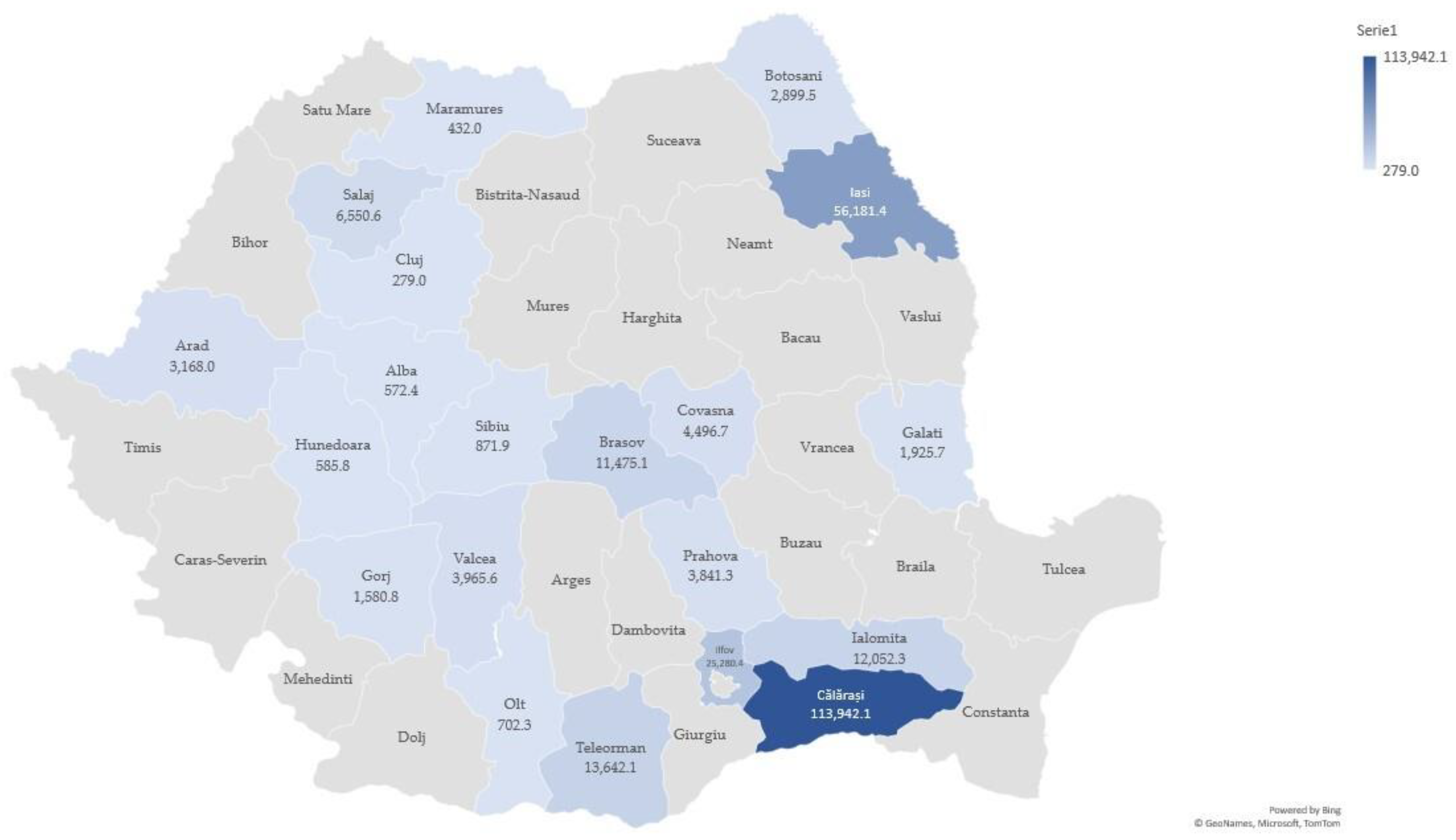
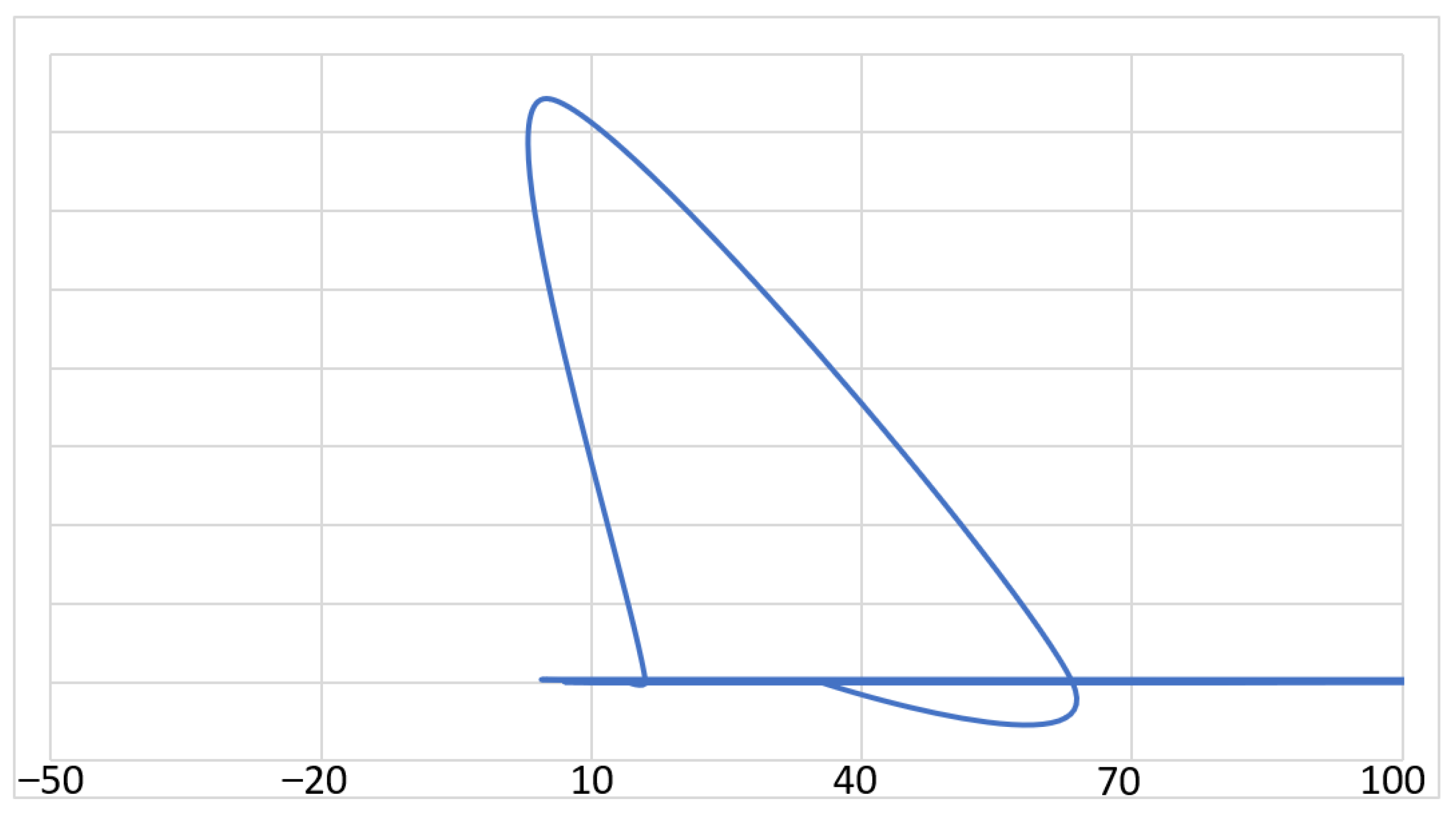


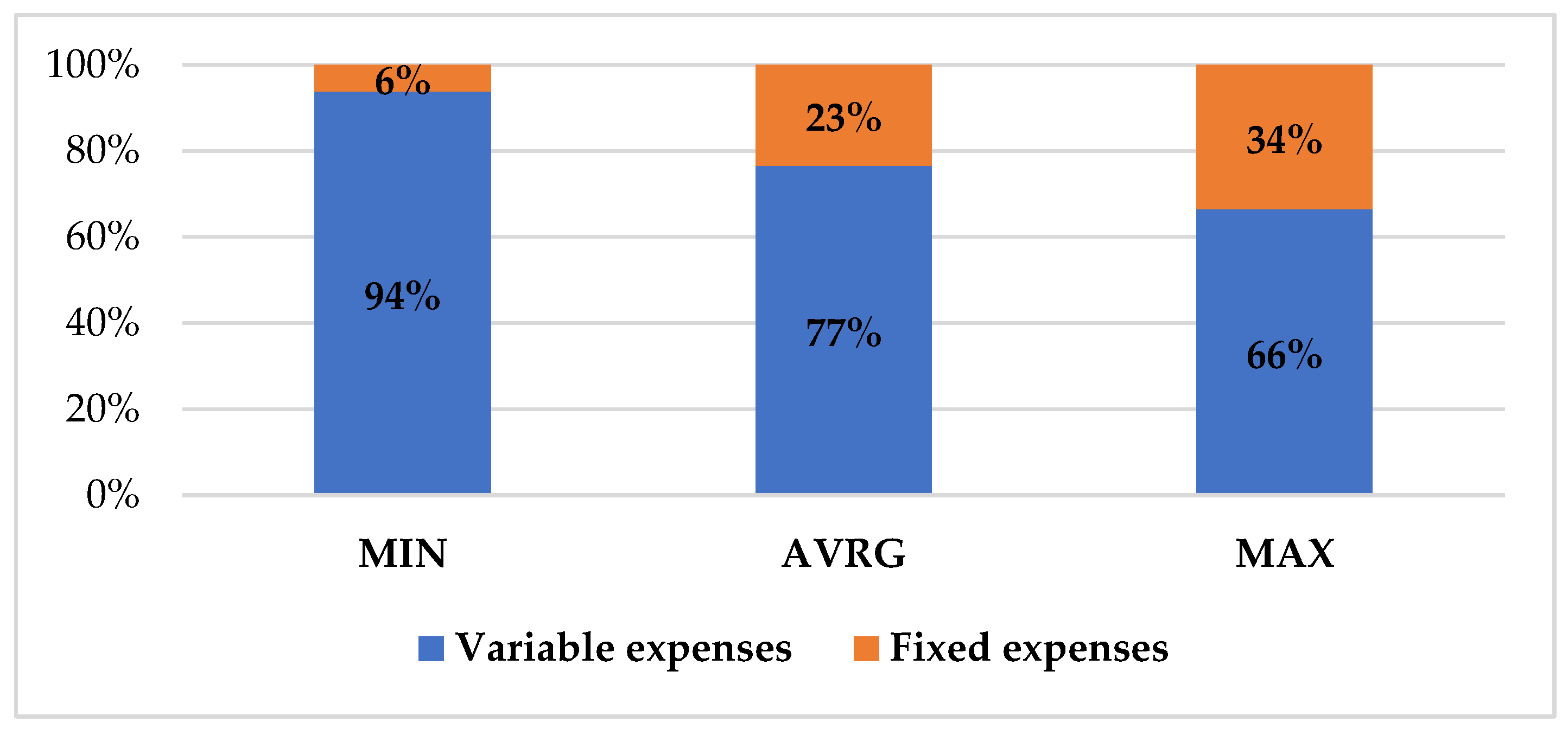
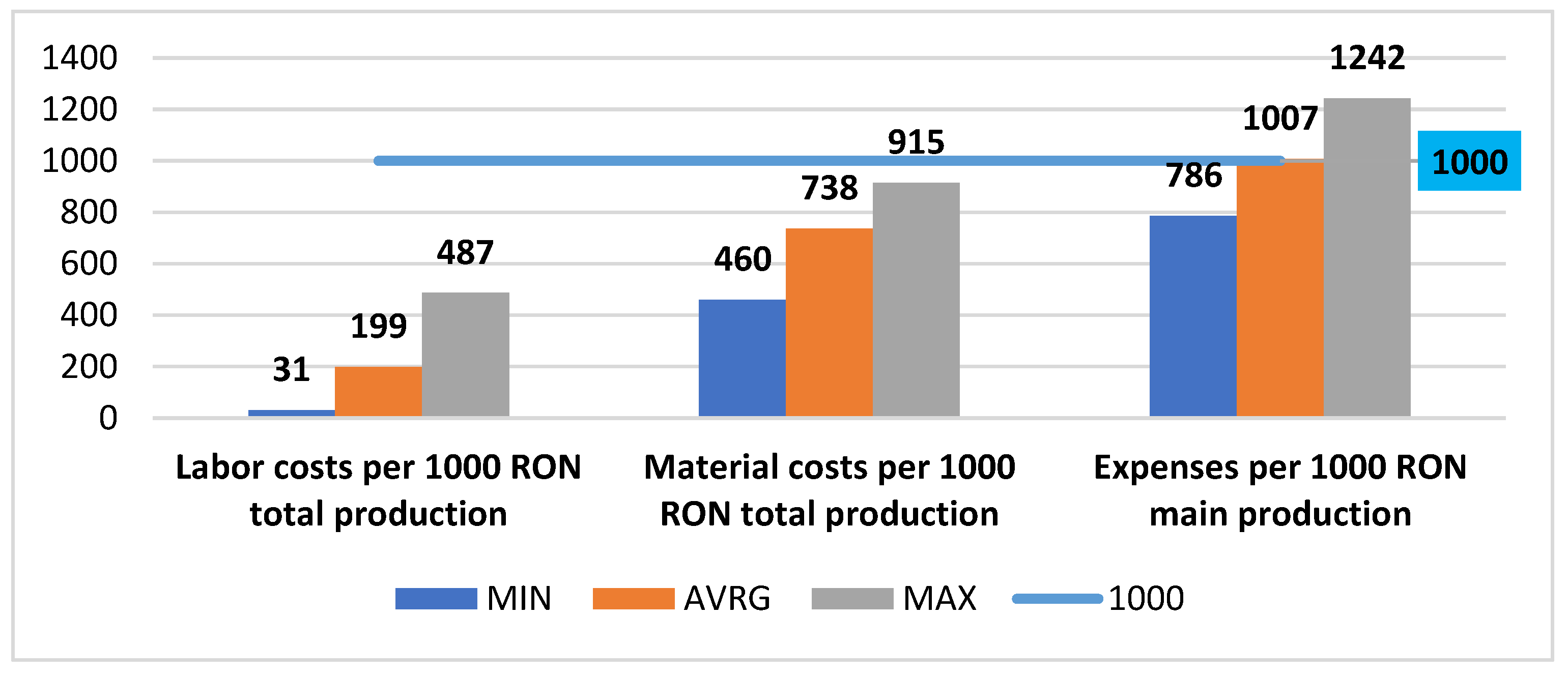

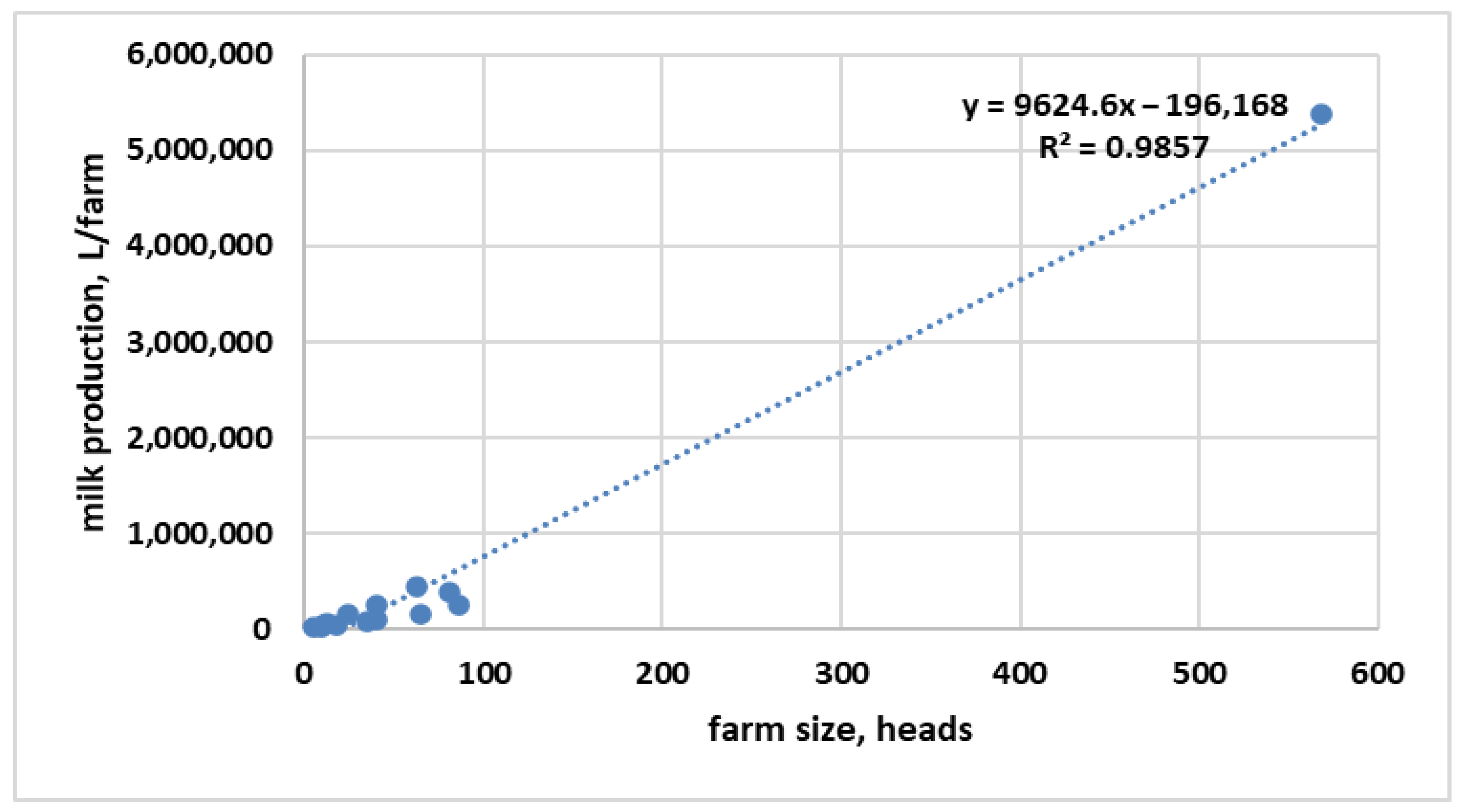

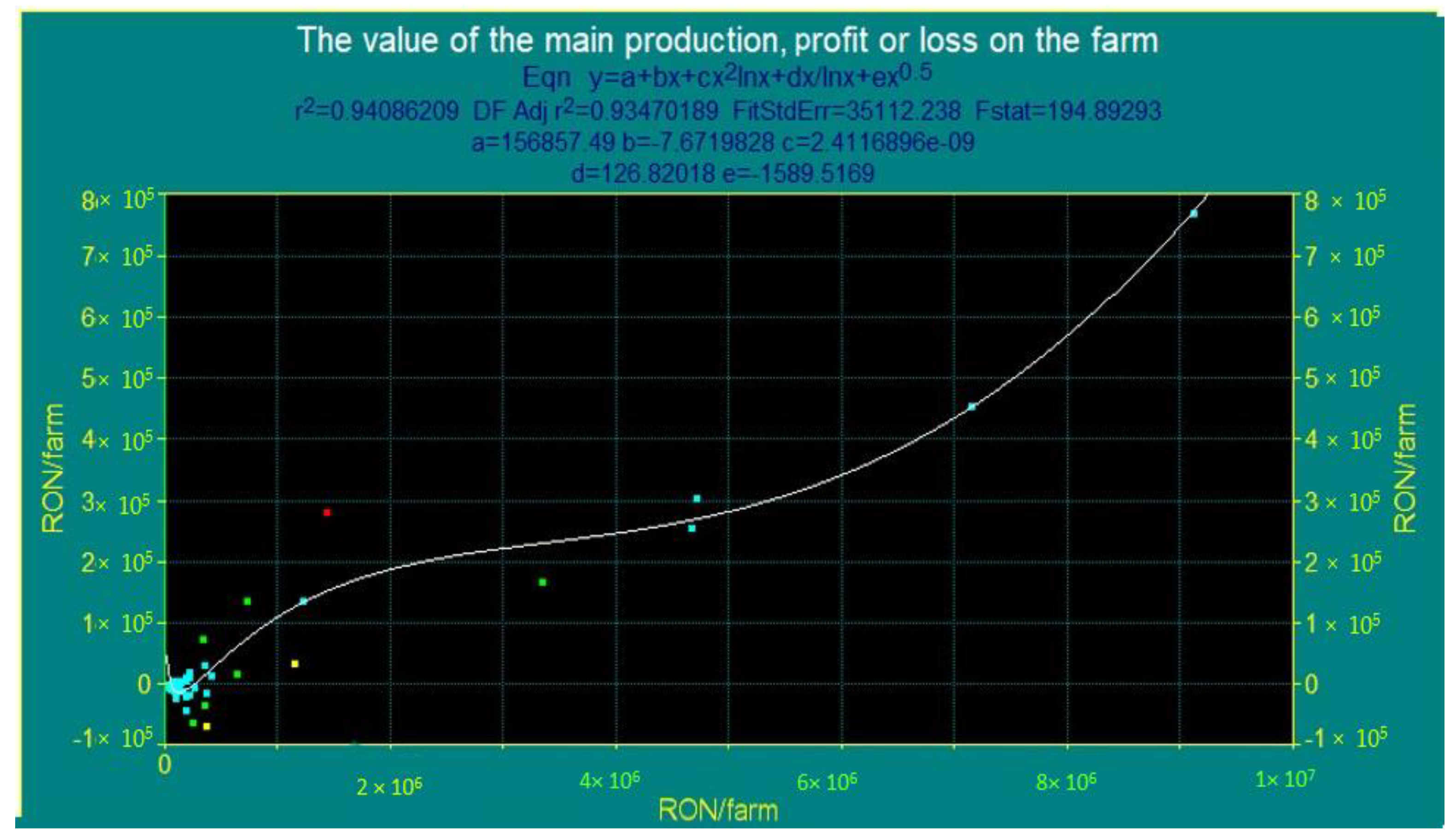
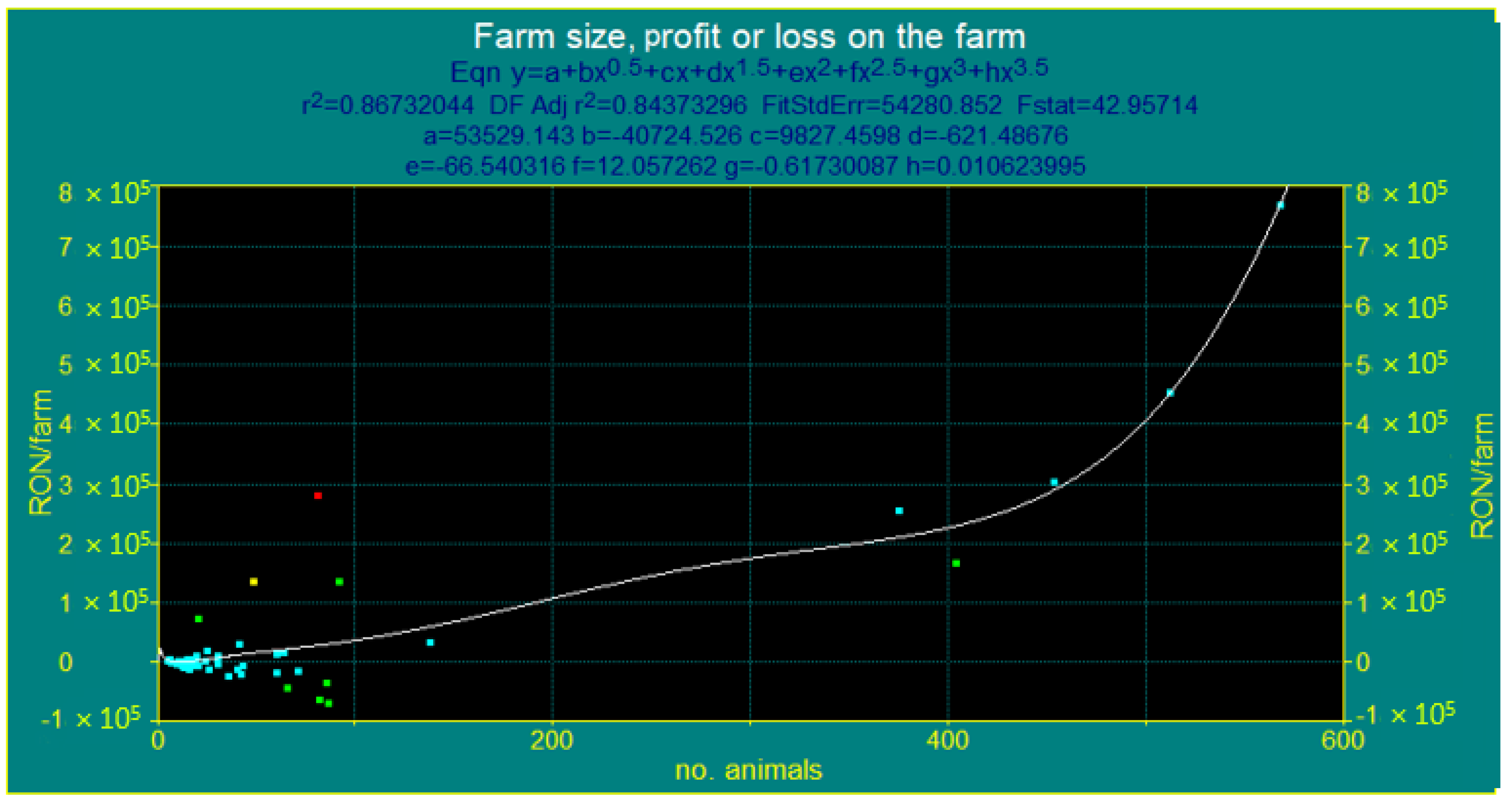

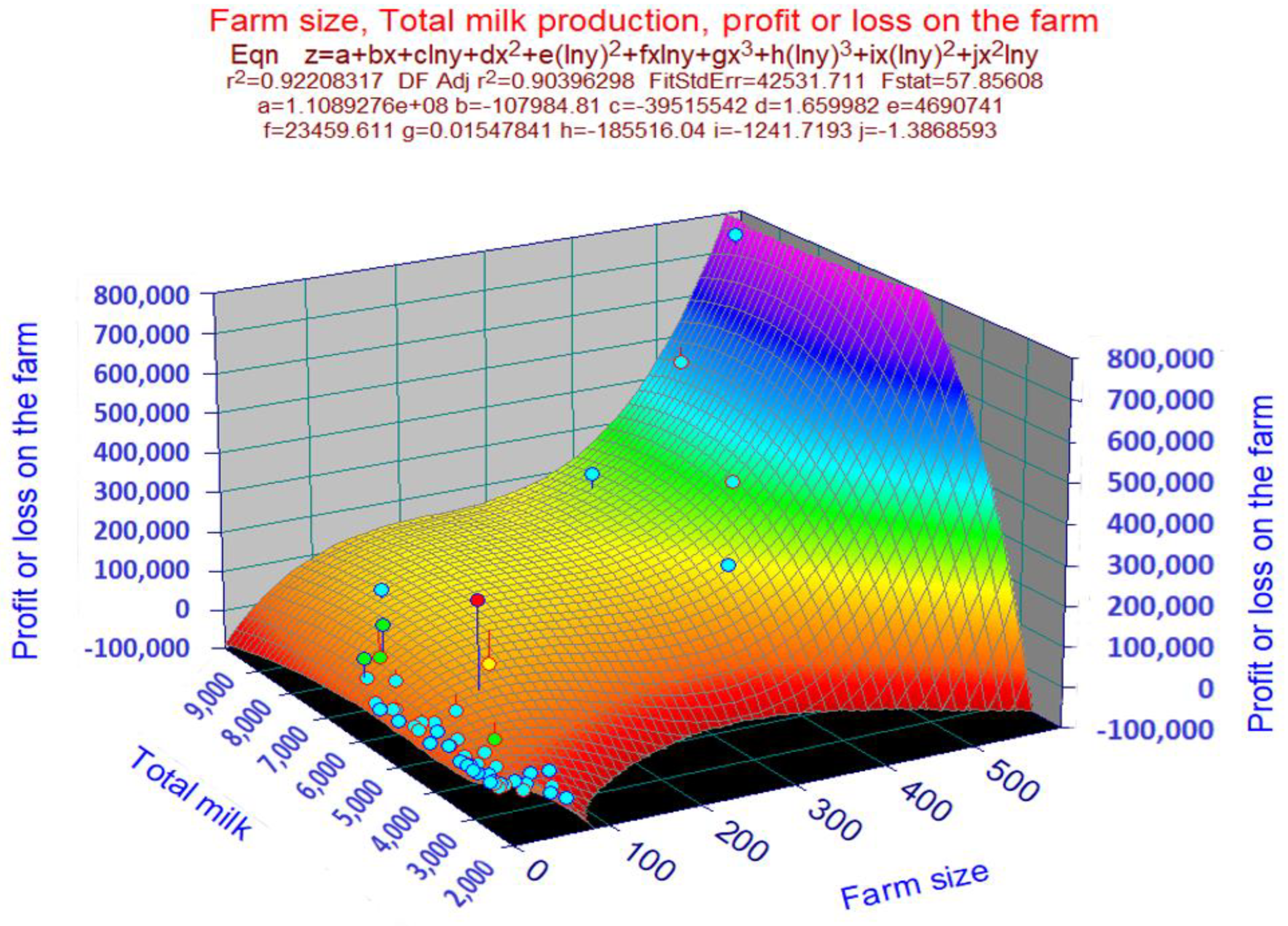
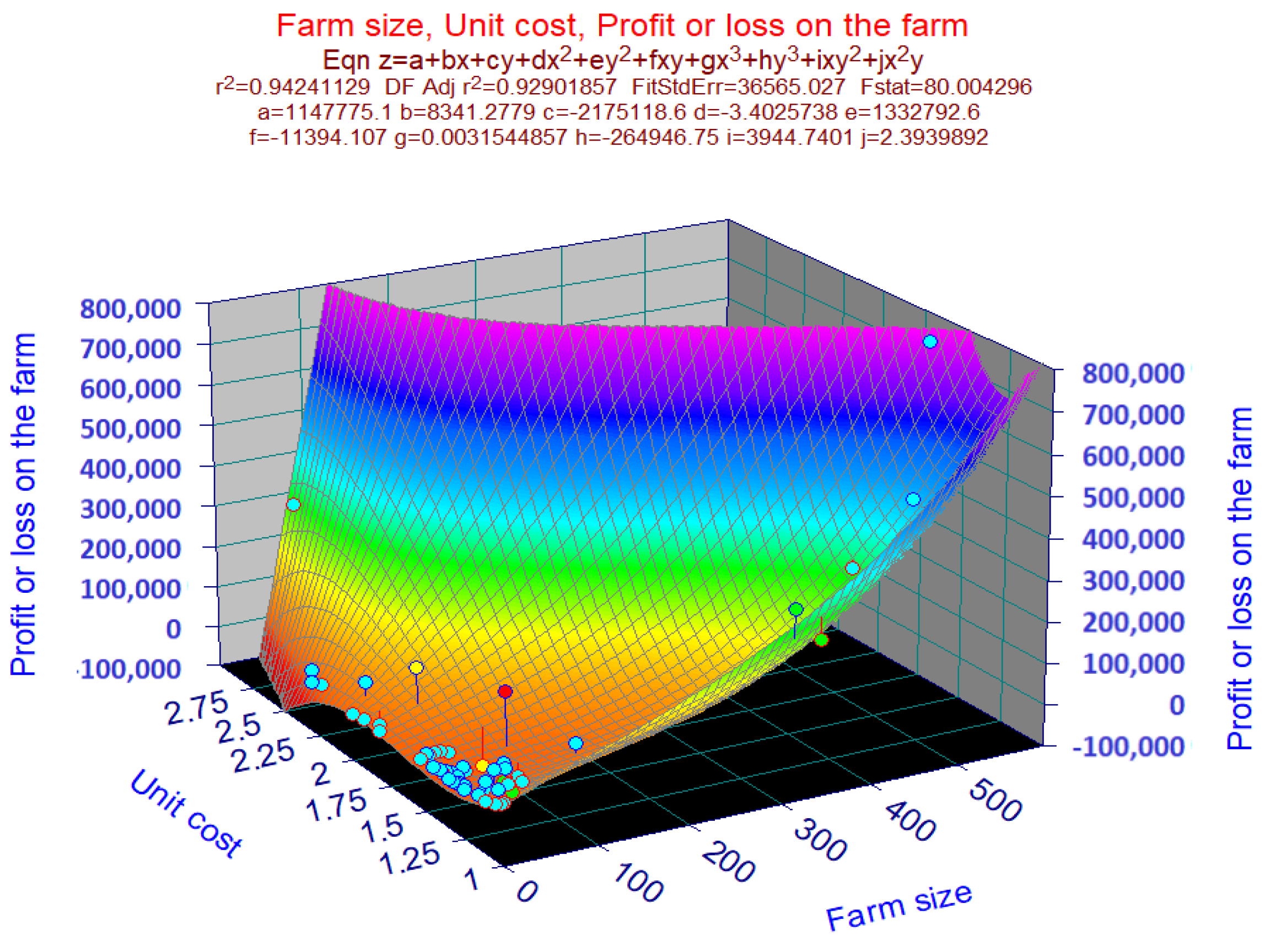
| Farm Size | |
|---|---|
| Mean | 73.44444 |
| Standard Error | 17.71771 |
| Median | 24.5 |
| Mode | 18.66667 |
| Standard Deviation | 130.1981 |
| Sample Variance | 16,951.53 |
| Kurtosis | 6.98522 |
| Skewness | 2.81767 |
| Range | 563.3333 |
| Minimum | 5 |
| Maximum | 568.3333 |
| Sum | 3966 |
| Count | 54 |
| Specification | Unit | Avrg | Standard Deviation |
|---|---|---|---|
| Farm size | cows | 73.44 | 130.2 |
| Average production | L/cow | 4554.94 | 1809.3 |
| Value of main production | USD/L | 0.38 | 0.12 |
| Costs for the main production | USD/L | 0.37 | 0.10 |
| Variable costs | USD/L | 0.32 | 0.05 |
| Material costs | USD/L | 0.30 | 0.05 |
| Fixed costs | USD/L | 0.10 | 0.05 |
| Labor costs | USD/L | 0.08 | 0.05 |
| Labor productivity in physical expression | Man-hours/L | 0.06 | 0.0 |
| Labor productivity in value expression | USD/man-hours | 10.52 | 10.96 |
| Labor costs at 1000 RON total production | USD | 48.08 | 21.35 |
| Material costs at 1000 RON total production | USD | 178.12 | 23.37 |
| Expenses per 1000 RON main production | USD | 243.28 | 24.20 |
| Profit or loss per unit of product | USD | 0.00 | 0.05 |
| Taxable income rate | % | 0.2 | 10.0 |
| Net income rate | % | −0.1 | 9.4 |
| Profitability threshold in value units | USD | 1937.84 | 761.98 |
| Profitability threshold in physical units | L | 5506 | 3048.7 |
| Exploitation risk rate | % | 146.6 | 132.7 |
| Security index | −0.5 | 1.3 |
Publisher’s Note: MDPI stays neutral with regard to jurisdictional claims in published maps and institutional affiliations. |
© 2022 by the authors. Licensee MDPI, Basel, Switzerland. This article is an open access article distributed under the terms and conditions of the Creative Commons Attribution (CC BY) license (https://creativecommons.org/licenses/by/4.0/).
Share and Cite
Chetroiu, R.; Cișmileanu, A.E.; Cofas, E.; Petre, I.L.; Rodino, S.; Dragomir, V.; Marin, A.; Turek-Rahoveanu, P.A. Assessment of the Relations for Determining the Profitability of Dairy Farms, A Premise of Their Economic Sustainability. Sustainability 2022, 14, 7466. https://doi.org/10.3390/su14127466
Chetroiu R, Cișmileanu AE, Cofas E, Petre IL, Rodino S, Dragomir V, Marin A, Turek-Rahoveanu PA. Assessment of the Relations for Determining the Profitability of Dairy Farms, A Premise of Their Economic Sustainability. Sustainability. 2022; 14(12):7466. https://doi.org/10.3390/su14127466
Chicago/Turabian StyleChetroiu, Rodica, Ana Elena Cișmileanu, Elena Cofas, Ionut Laurentiu Petre, Steliana Rodino, Vili Dragomir, Ancuța Marin, and Petruța Antoneta Turek-Rahoveanu. 2022. "Assessment of the Relations for Determining the Profitability of Dairy Farms, A Premise of Their Economic Sustainability" Sustainability 14, no. 12: 7466. https://doi.org/10.3390/su14127466
APA StyleChetroiu, R., Cișmileanu, A. E., Cofas, E., Petre, I. L., Rodino, S., Dragomir, V., Marin, A., & Turek-Rahoveanu, P. A. (2022). Assessment of the Relations for Determining the Profitability of Dairy Farms, A Premise of Their Economic Sustainability. Sustainability, 14(12), 7466. https://doi.org/10.3390/su14127466








